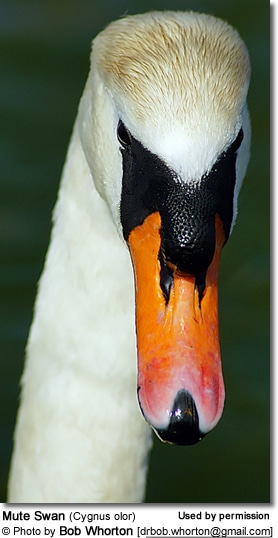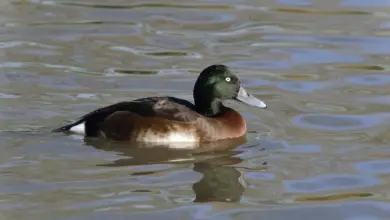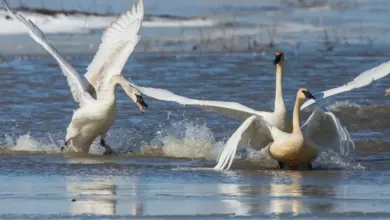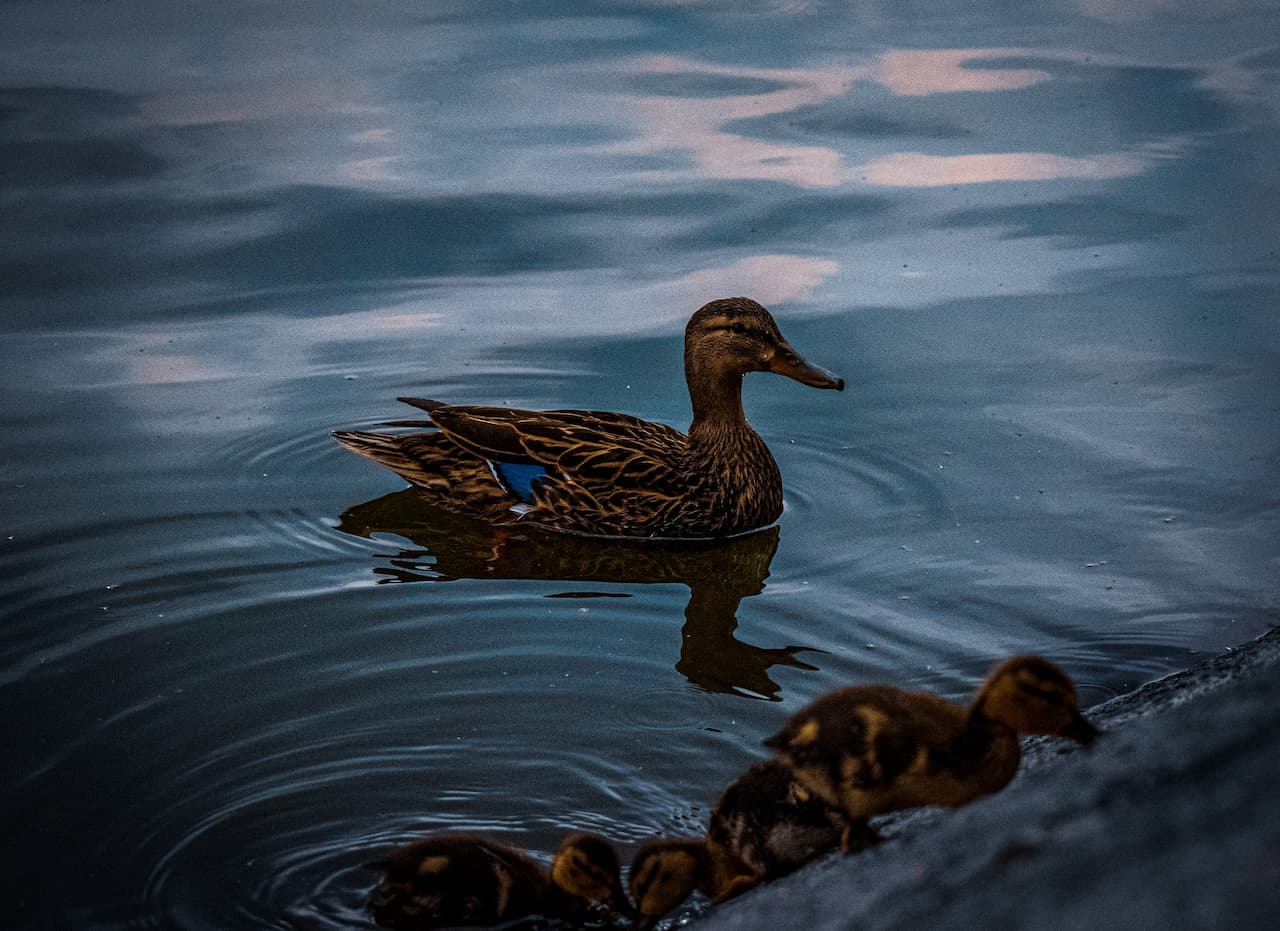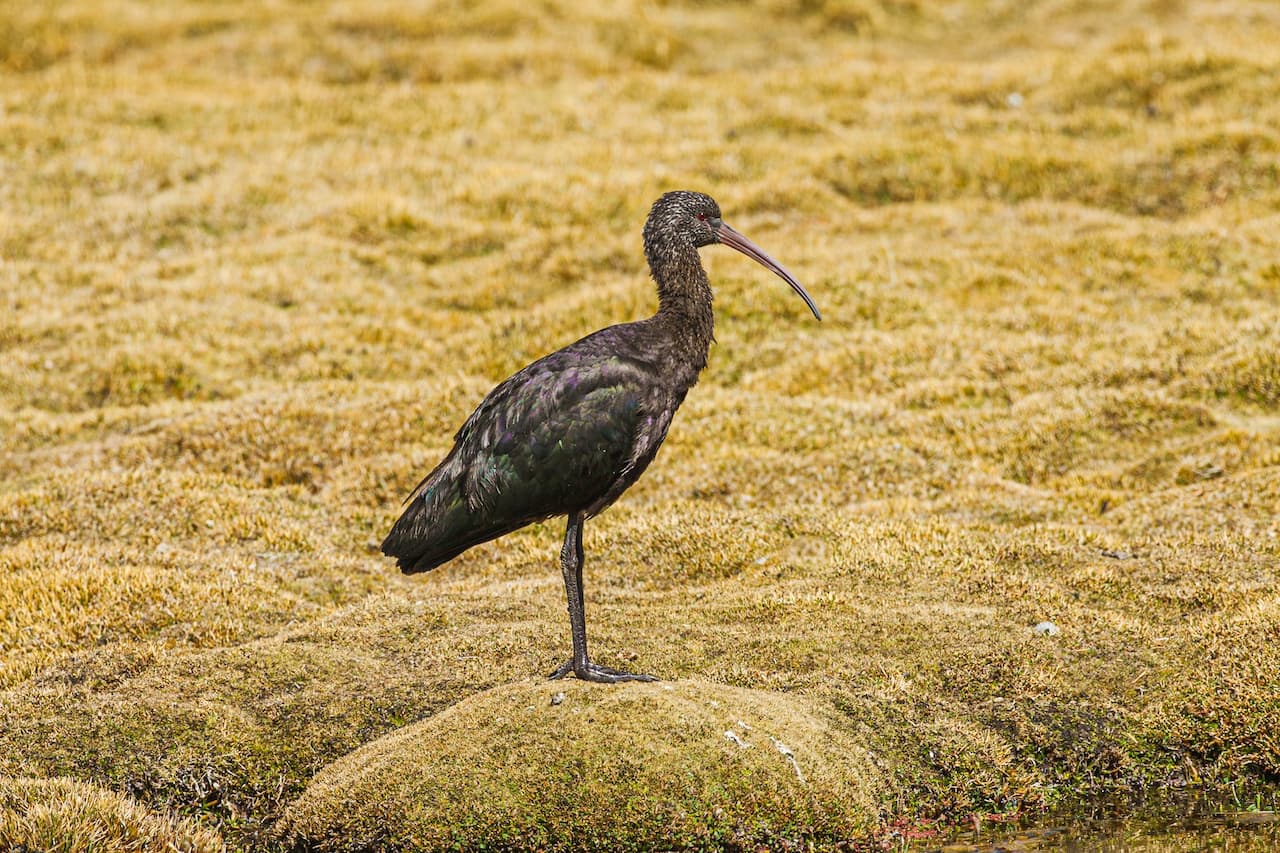Mute Swans (Cygnus olor)
The Mute Swans (Cygnus olor) – also sometimes referred to as the “White Swan” – is native to Europe and Asia, and is a rare vagrant to the far north of Africa. Its closest relatives are the Black Swan of Australia and the Black-necked Swan of South America.

- Mute Swan Mating, Breeding and Nesting Behavior and Related Photos
- Mute Swans Photo Contributions by Avianweb Visitors
- Mute Swan Distributions, Habitat, Populations
- Description / Identification
- Global Names
- The Diet of Swans and Feeding Swans
Mute Swans are popular as privately kept waterfowl in park lakes, as well as water areas in zoos or bird collections.
The name ‘mute’ derives from it being less vocal than other swan species
The male is called a “cob” – from Middle English cobbe (leader of a group); the female “pen,” and their chicks are known as “cygnets” – from the Latin word for swan, cygnus.
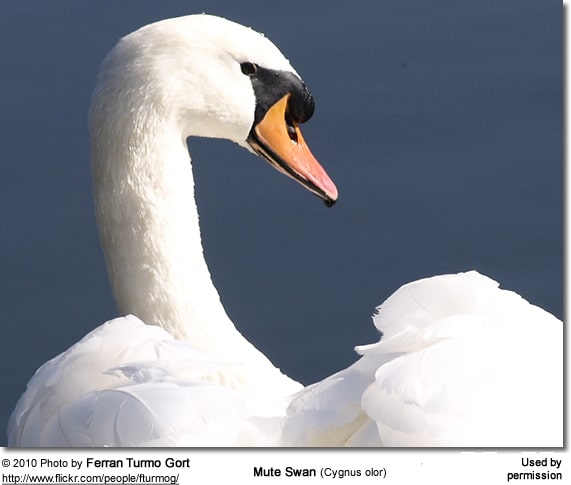
Distribution and Habitat
The Mute Swan is native to the temperate areas of Europe across western Asia.
The U.N. Environmental Programme places the Mute Swan in 70 countries, breeding in 49 countries, and vagrant in 16 countries.
Within its native range, the Mute Swan population is estimated to consist of 500,000 birds; 350,000 of which occur in the former Soviet Union.
This migratory species is Europe and Asia. They breed in the British Isles, north central Europe, and north central Asia. They migrate south to winter as far south as North Africa, the Near East and to northwest India and Korea.
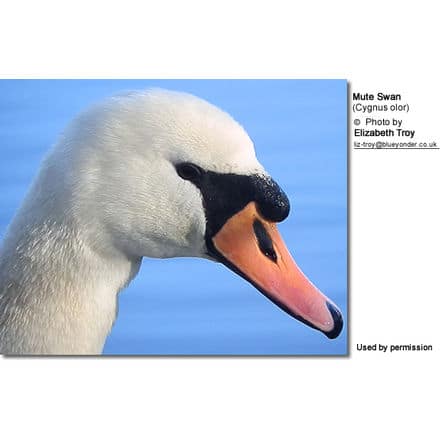
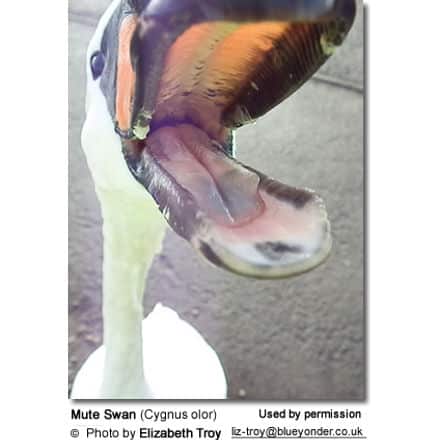
Mute Swans are native to (major areas highlighted):
- Afghanistan, Albania, Armenia, Austria, Azerbaijan, Belarus, Belgium, Bosnia and Herzegovina
- Bulgaria: Atanasovsko Lake, Pomorie Lake, Yatata
- China : mainland – Ebi Nur and Kuytun River
- Croatia, Cyprus, Czech Republic
- Denmark: Estimated population of 4,500 pairs found in the following areas: (Hyllekrog-Rødsand and Fehmarn Belt, Nakskov Fjord and Indrefjord, Odense Fjord, Præstø Fjord, Ulvshale, Nyord and Jungshoved Nor, Roskilde Fjord, Selsø and Kattinge Søerne, Saltholm, Smålandsfarvandet, Ulvsund, Grønsund, Farø Fjord and Fanefjord) 4,500 pairs in Denmark
- Estonia: Küdema bay, Pärnu bay, Väinameri, Vilsandi archipelago
- Finland, France
- Germany: 6,800-8,300 breeding pairs
- Greece: Evros delta, Lake Mitrikou, Megalo and Mikro Livari lagoons Istieas, Nestou delta and coastal lagoons, Porto Lagos, Lake Vistonis and coastal lagoons
- Hungary, India
- Iran: Anzali Mordab complex
- Iraq
- Ireland:: Estimated 2,500 pairs
- Israel, Italy, Japan

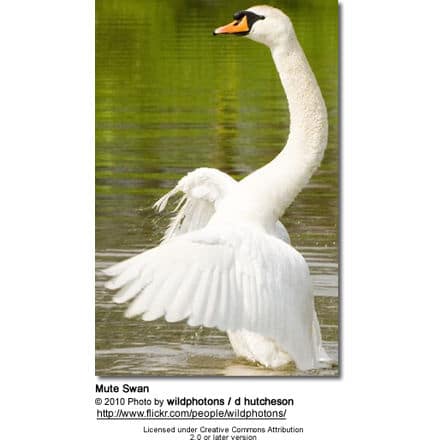
- Kazakhstan: Karakol Lake
- Kyrgyzstan, Latvia (Irbe strait), Liechtenstein, Lithuania, Luxembourg, Macedonia, Moldova, Mongolia, Montenegro
- Netherlands:: 3,000-4,000 pairs
- North Korea: Kumya Bay, Lake Kwangpo, Lake Samilpo, Lake Tungjong and Lake Chonapo, Taedong River estuary
- Norway, Pakistan
- Poland: 4,000-4,200 pairs
- Romania: Arge? reservoir, Buhu?u reservoir – Bac?u – T?t?r??ti, Crja – Ma?a – R?deanu – Ro?cani, Danube Delta, Olt valley
- Russia – Asian: Aniva bay, Kunashir island, Kuril islands between Urup and Paramushir; European Russia: Dadynskiye lakes, Delta of the Kuban’ river, Delta of the River Don, Kazachka , Kiziltash limans, Taman’, Veselovskoye reservoir, Western Ilmen area – the largest single breeding propulation of about 11,000 pairs is found in the Volga Delta (the northern part of the Caspian Sea, the largest enclosed body of water on Earth); and Central Asian
- Serbia, Slovakia, Slovenia
- South Korea: Hwajinpo-ho lake
- Spain
- Sweden: Bay of Kungsbackafjorden
- Switzerland, Taiwan
- Turkey: Meric delta
- Turkmenistan
- Ukraine: Estimated population of 1,200-1,700 pairs found in the following areas: Budats’kyj lyman, Dnipro delta, Jansheijs’ke lake, Karkinits’ka and Dzharylgats’ka bays, Kugurluj and Kartal lakes, Molochnyj Liman, Pryp’yat’ river valley, Sasyk lake, Shagany-Alibej-Burnas lake-system, Stentsivs’ko-Zhebriyanivs’ki plavni, Syvash Bay, Tyligul’s’kyj lyman, Utlyuk lyman, Yagorlyts’ka and Tendrivs’ka Bays
- United Kingdom: Estimated population of 22,000 birds – of which over 100 pairs occur as at the colony at Abbotsbury Swannery in southern England, at the southern tip of Öland Island, Ottenby Preserve, in the coastal waters of the Baltic Sea; a maximum of 787 non-breeding birds are found on the River Tweed estuary at Berwick-upon-Tweed in northeastern England
- Uzbekistan: Sudochye Lake



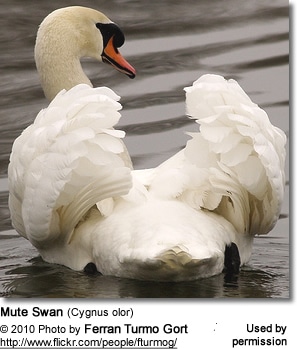
Vagrants
- Bahrain, Bermuda, Egypt, Jordan, Lebanon, Libya, Malta, Morocco, Oman, Palestinian Authority Territories, Portugal, Syria, Tajikistan, United Arab Emirates
Introduced
- Southwestern Australia and New Zealand: Less than 200 Mute Swans
- Canada, Faroe Islands, Iceland,
- Japan: About 200 Mute Swans
- Singapore
- South Africa: Estimated of having a population of about 120 Mute Swans
- United States: Populations have established along the Atlantic Coast from Massachusetts to Virginia and the Great Lakes area

Preferred Habitats
- Marine coastal, including brackish/saline and freshwater lagoons
- Wetlands, including Bogs, marshes, swamps, fens, peatlands, freshwater lakes, rivers, streams, creeks
Alternate (Global) Names
Chinese: ???? … Czech:labu? velká … Dutch: Knobbel zwaan, Knobbelzwan … German: Höckerschwan … Danish: Knopsvane … Finnish: kyhmyjoutsen … French: Cygne tuberculé, Cygne muet … Icelandic: Hnúðsvanur … Italian: Cigno reale … Japanese: kobuhakuchou, ??????? … Norwegian: Knoppsvane … Polish: ?ab?d? niemy … Portuguese: Cisne-vulgar … Slovak: labu? ve?ká … Spanish: Cisne Vulgar, Cisne mudo … Swedish: Knölsvan
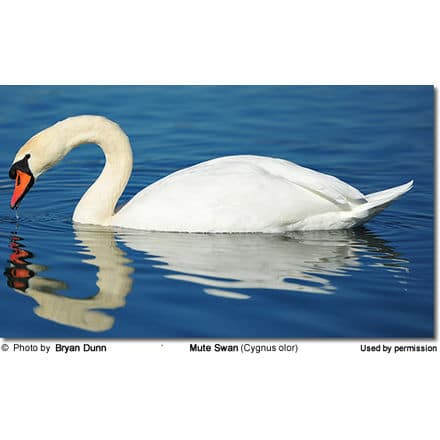
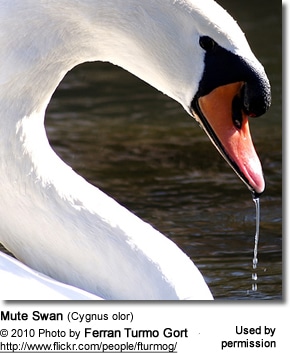
Description
Size:
Adults Mute Swans measure 49 – 67 inches (125 – 170 cm) in length and have a wingspan of 79 – 94 in ( 200 – 240 cm). They stand up to 47 inches or 1.2 meter tall.
They are one of the highest flying birds – with males averaging 26 lbs (12 kg) and females averaging 33 lbs (15 kg). The heaviest flying bird ever recorded was a Polish male Mute Swan which weighed in at 51 lbs (23 kg), surpassing the larger Trumpeter Swan.
Other Physical Characteristics:
The plumage is all white; except the head and neck are often stained a dull tan or orange color due to exposure to iron-rich waters and mud as they dive under water to forage for food. They have a thick layer of down that protects them in subzero temperatures.
Like all water birds, they spend a good amount of time preening their feathers. As part of preening, the swan presses the bill against an oil gland (located at the base of its tail) to extract a greasy fluid that they redistribute over their plumage to waterproof the feathers.
The orangey-red bill has a black tip and base. There is a pronounced knob atop the bill. They have a gently curved neck.
The morph (genetic mutation) immutabilis (“Polish Swan”) has pinkish instead of dark grey legs; and the juveniles are dull white.
Male and female ID: They look mostly alike. Some difference in size may be noticeable, but it is not a reliable method. During the breeding season, the male’s knob swells and becomes noticeable larger than the females.
Juveniles have either a grey or white plumage. Their color at hatch is a genetic trait and not related to gender. Grey cygnets gradually turn brownish by their first winter, before gaining their white adult plumage. White cygnets remain white.
The white cygnets have a leucistic gene . For the first year, the bill is dull greyish-black instead of orange.
Similar Species: In general, the Mute Swan can easily be identified by its large size and orange-reddish bill. It is also longer-tailed than other swans. It can be distinguished from other North American swan species by the knob atop the bill.
It does resembles the Whooper Swan, but it has a yellow and black bill, lacks the curved neck and characteristic projection above the bill, and is longer and heavier.
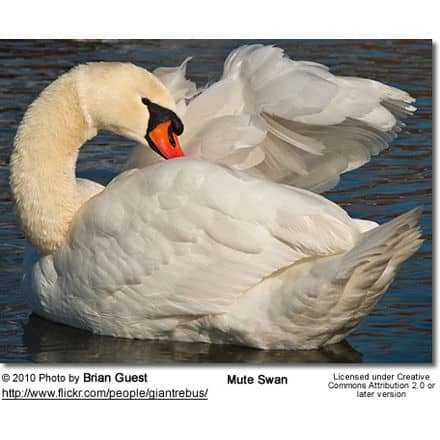
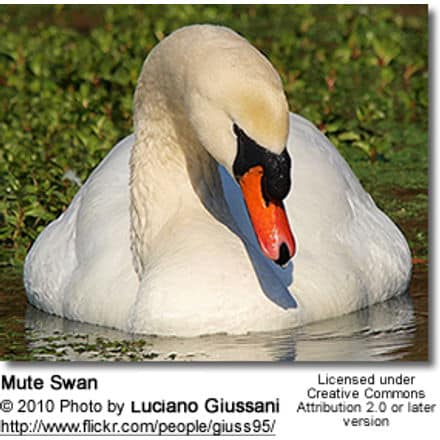
Diet / Feeding:
What they eat …
Swans feed primarily on aquatic plants; but they also eat grain, grasses and crop foods, such as wheat, potatoes and carrots – especially in the winter when other food sources aren’t readily available.
Mute Swans will also eat insects, fish and frogs.
Only young cygnets (immature swans) eat aquatic insects and crustaceans, as they have a higher requirement for protein than the adults. As they get older, their diet changes over to a plant diet, which includes aquatic vegetation and roots.
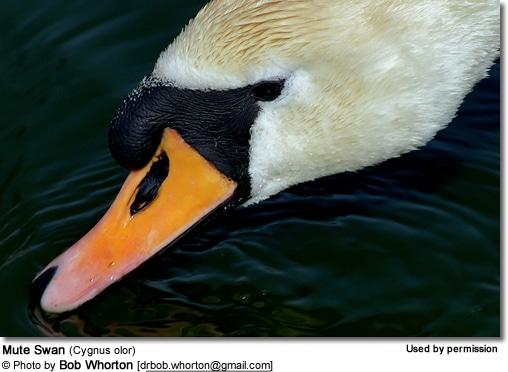

How they eat …
In shallow water, Swans may use their strong webbed feet to dig into submerged mud and, like mallards, they tip up – plunging the head and neck underwater – to expose and feed on roots, shoots and tubers. The cygnets feed on invertebrates and aquatic vegetation stirred up by their foraging parents. Ducks and other water birds also often follow swans to forage on exposed plant matter and aquatic insects. Cygnets feed on invertebrates and aquatic vegetation stirred up by their foraging parents.
Their long necks give them an advantage over the short-necked ducks, as they can feed in deeper waters than geese or ducks. They can feed in waters that are up to 4 feet (1.2 meters) deep by uprooting plants and snapping off the leaves and stems of plants growing underwater.
Swans also forage by swimming picking up plant material from the water’s surface or water’s edge. On land, they feed on grains and grasses.
- The Diet of Swans and Feeding Swans
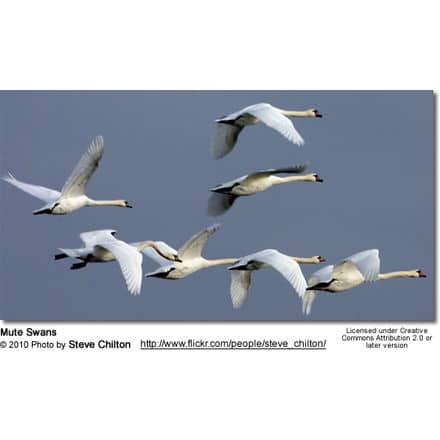

Calls / Vocalizations
Their vocalizations consists of grunting, hoarse whistling and snorting noises, particularly when communicating with their young. They usually hiss at predators.
The Mute Swan is less vocal than other Swans. Its most familiar sound is the vibrant throbbing of its wings in flight, which is unique to this species and can be heard for up to 1 mile or 2 kilometers..
Lifespan / Age
Swans are known to live 20 to 30 years. Swans form pair bonds when they are two to four years old and remain bonded for life. The first nesting usually occurs when they are 4 or 5 years old.
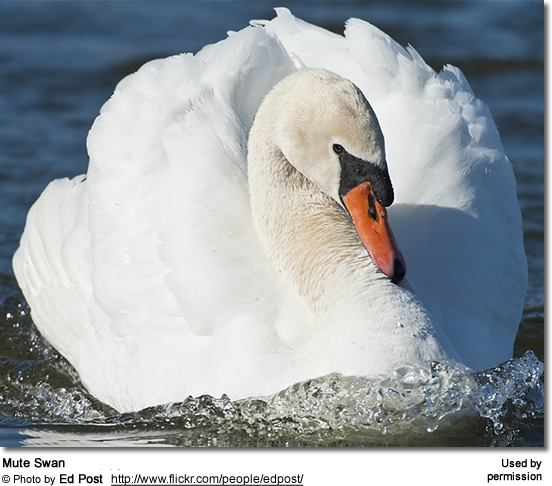
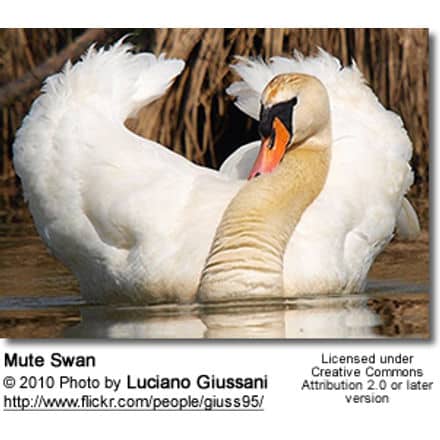
Status
The Mute Swan is protected in most of its range, but this has not prevented illegal hunting and poaching.
In Western Europe, Mute Swans were hunted to extinction in the 13th – 19th centuries. Only captive populations survived.
In the 19th and 20th centuries, they were provided more legal protection and rebound in most of their native range.
Between 1960 up to early 1980s, their numbers declined significantly due to lead poisoning from birds swallowing discarded fishing sinkers made from lead. Since then these lead sinkers were replaced with less toxic alternatives and the populations are increasing again.
Species Research by Sibylle Johnson
Relevant Web Resources
- Swan Information and Photos
- Listing of Swan Species and Their Ranges
- Photos of the Various Swan Species for Identification

Mute Swan Mating, Breeding and Nesting Behavior and Related Photos
- Mute Swans Photo Contributions by Avianweb Visitors
- Mute Swan Distributions, Habitat, Populations
- Description / Identification
- Global Names
- The Diet of Swans and Feeding Swans
The Mute Swan (Cygnus olor) – also sometimes referred to as “White Swan” – is native to much of Europe and Asia, and is a rare vagrant to the far north of Africa. Its closest relatives are the Black Swan of Australia and the Black-necked Swan of South America.
Mute Swans are popular as privately kept waterfowl in park lakes, as well as water areas in zoos or bird collections.
The name ‘mute’ derives from it being less vocal than other swan species
The male is called a “cob” – from Middle English cobbe (leader of a group); the female “pen,” and their chicks are known as “cygnets” – from the Latin word for swan, cygnus.

Distribution and habitat
The Mute Swan is native to the temperate areas of Europe across western Asia.
The U.N. Environmental Programme places the Mute Swan in 70 countries, breeding in 49 countries, and vagrant in 16 countries.
Within its native range, the Mute Swan population is estimated to consist of 500,000 birds; 350,000 of which occur in the former Soviet Union.
This migratory species is Europe and Asia. They breed in the British Isles, north central Europe, and north central Asia. They migrate south to winter as far south as North Africa, the Near East and to northwest India and Korea.


- Afghanistan, Albania, Armenia, Austria, Azerbaijan, Belarus, Belgium, Bosnia and Herzegovina
- Bulgaria: Atanasovsko Lake, Pomorie Lake, Yatata
- China : mainland – Ebi Nur and Kuytun River
- Croatia, Cyprus, Czech Republic
- Denmark: Estimated population of 4,500 pairs found in the following areas: (Hyllekrog-Rødsand and Fehmarn Belt, Nakskov Fjord and Indrefjord, Odense Fjord, Præstø Fjord, Ulvshale, Nyord and Jungshoved Nor, Roskilde Fjord, Selsø and Kattinge Søerne, Saltholm, Smålandsfarvandet, Ulvsund, Grønsund, Farø Fjord and Fanefjord) 4,500 pairs in Denmark
- Estonia: Küdema bay, Pärnu bay, Väinameri, Vilsandi archipelago
- Finland, France
- Germany: 6,800-8,300 breeding pairs
- Greece: Evros delta, Lake Mitrikou, Megalo and Mikro Livari lagoons Istieas, Nestou delta and coastal lagoons, Porto Lagos, Lake Vistonis and coastal lagoons
- Hungary, India
- Iran: Anzali Mordab complex
- Iraq
- Ireland:: Estimated 2,500 pairs
- Israel, Italy, Japan


- Kazakhstan: Karakol Lake
- Kyrgyzstan, Latvia (Irbe strait), Liechtenstein, Lithuania, Luxembourg, Macedonia, Moldova, Mongolia, Montenegro
- Netherlands:: 3,000-4,000 pairs
- North Korea: Kumya Bay, Lake Kwangpo, Lake Samilpo, Lake Tungjong and Lake Chonapo, Taedong River estuary
- Norway, Pakistan
- Poland: 4,000-4,200 pairs
- Romania: Arge? reservoir, Buhu?u reservoir – Bac?u – T?t?r??ti, Crja – Ma?a – R?deanu – Ro?cani, Danube Delta, Olt valley
- Russia – Asian: Aniva bay, Kunashir island, Kuril islands between Urup and Paramushir; European Russia: Dadynskiye lakes, Delta of the Kuban’ river, Delta of the River Don, Kazachka , Kiziltash limans, Taman’, Veselovskoye reservoir, Western Ilmen area – the largest single breeding propulation of about 11,000 pairs is found in the Volga Delta (the northern part of the Caspian Sea, the largest enclosed body of water on Earth); and Central Asian
- Serbia, Slovakia, Slovenia
- South Korea: Hwajinpo-ho lake
- Spain
- Sweden: Bay of Kungsbackafjorden
- Switzerland, Taiwan
- Turkey: Meric delta
- Turkmenistan
- Ukraine: Estimated population of 1,200-1,700 pairs found in the following areas: Budats’kyj lyman, Dnipro delta, Jansheijs’ke lake, Karkinits’ka and Dzharylgats’ka bays, Kugurluj and Kartal lakes, Molochnyj Liman, Pryp’yat’ river valley, Sasyk lake, Shagany-Alibej-Burnas lake-system, Stentsivs’ko-Zhebriyanivs’ki plavni, Syvash Bay, Tyligul’s’kyj lyman, Utlyuk lyman, Yagorlyts’ka and Tendrivs’ka Bays
- United Kingdom: Estimated population of 22,000 birds – of which over 100 pairs occur as at the colony at Abbotsbury Swannery in southern England, at the southern tip of Öland Island, Ottenby Preserve, in the coastal waters of the Baltic Sea; a maximum of 787 non-breeding birds are found on the River Tweed estuary at Berwick-upon-Tweed in northeastern England
- Uzbekistan: Sudochye Lake




Vagrants:
- Bahrain, Bermuda, Egypt, Jordan, Lebanon, Libya, Malta, Morocco, Oman, Palestinian Authority Territories, Portugal, Syria, Tajikistan, United Arab Emirates
Introduced:
- Southwestern Australia and New Zealand: Less than 200 Mute Swans
- Canada, Faroe Islands, Iceland,
- Japan: About 200 Mute Swans
- Singapore
- South Africa: Estimated of having a population of about 120 Mute Swans
- United States: Populations have established along the Atlantic Coast from Massachusetts to Virginia and the Great Lakes area

Preferred Habitats:
- Marine coastal, including brackish/saline and freshwater lagoons
- Wetlands, including Bogs, marshes, swamps, fens, peatlands, freshwater lakes, rivers, streams, creeks
Alternate (Global) Names
Chinese: ???? … Czech:labu? velká … Dutch: Knobbel zwaan, Knobbelzwan … German: Höckerschwan … Danish: Knopsvane … Finnish: kyhmyjoutsen … French: Cygne tuberculé, Cygne muet … Icelandic: Hnúðsvanur … Italian: Cigno reale … Japanese: kobuhakuchou, ??????? … Norwegian: Knoppsvane … Polish: ?ab?d? niemy … Portuguese: Cisne-vulgar … Slovak: labu? ve?ká … Spanish: Cisne Vulgar, Cisne mudo … Swedish: Knölsvan


Description
Size:
Adults Mute Swans measure 49 – 67 inches (125 – 170 cm) in length and have a wingspan of 79 – 94 in ( 200 – 240 cm). They stand up to 47 inches or 1.2 meter tall.
They are one of the highest flying birds – with males averaging 26 lbs (12 kg) and females averaging 33 lbs (15 kg). The heaviest flying bird ever recorded was a Polish male Mute Swan which weighed in at 51 lbs (23 kg), surpassing the larger Trumpeter Swan.
Other Physical Characteristics:
The plumage is all white; except the head and neck are often stained a dull tan or orange color due to exposure to iron-rich waters and mud as they dive under water to forage for food. They have a thick layer of down that protects them in subzero temperatures. Like all water birds, they spend a good amount of time preening their feathers. As part of preening, the swan presses the bill against an oil gland (located at the base of its tail) to extract a greasy fluid that they redistribute over their plumage to waterproof the feathers.
The orangey-red bill has a black tip and base. There is a pronounced knob atop the bill. They have a gently curved neck.
The morph (genetic mutation) immutabilis (“Polish Swan”) has pinkish instead of dark grey legs; and the juveniles are dull white.
Male and female ID: They look mostly alike. Some difference in size may be noticeable, but it is not a reliable method. During the breeding season, the male’s knob swells and becomes noticeable larger than the females.
Juveniles have either a grey or white plumage. Their color at hatch is a genetic trait and not related to gender. Grey cygnets gradually turn brownish by their first winter, before gaining their white adult plumage. White cygnets remain white.
The white cygnets have a leucistic gene . For the first year, the bill is dull greyish-black instead of orange.
Similar Species: In general, the Mute Swan can easily be identified by its large size and orange-reddish bill. It is also longer-tailed than other swans. It can be distinguished from other North American swan species by the knob atop the bill.
It does resembles the Whooper Swan, but it has a yellow and black bill, lacks the curved neck and characteristic projection above the bill, and is longer and heavier.


What they eat …
Swans feed primarily on aquatic plants; but they also eat grain, grasses and crop foods, such as wheat, potatoes and carrots – especially in the winter when other food sources aren’t readily available.
Mute Swans will also eat insects, fish and frogs.
Only young cygnets (immature swans) eat aquatic insects and crustaceans, as they have a higher requirement for protein than the adults. As they get older, their diet changes over to a plant diet, which includes aquatic vegetation and roots.


How they eat …
In shallow water, Swans may use their strong webbed feet to dig into submerged mud and, like mallards, they tip up – plunging the head and neck underwater – to expose and feed on roots, shoots and tubers. The cygnets feed on invertebrates and aquatic vegetation stirred up by their foraging parents. Ducks and other water birds also often follow swans to forage on exposed plant matter and aquatic insects. Cygnets feed on invertebrates and aquatic vegetation stirred up by their foraging parents.
Their long necks give them an advantage over the short-necked ducks, as they can feed in deeper waters than geese or ducks. They can feed in waters that are up to 4 feet (1.2 meters) deep by uprooting plants and snapping off the leaves and stems of plants growing underwater.
Swans also forage by swimming picking up plant material from the water’s surface or water’s edge. On land, they feed on grains and grasses.
- The Diet of Swans and Feeding Swans


Calls / Vocalizations
Their vocalizations consists of grunting, hoarse whistling and snorting noises, particularly when communicating with their young. They usually hiss at predators.
The Mute Swan is less vocal than other Swans. Its most familiar sound is the vibrant throbbing of its wings in flight, which is unique to this species and can be heard for up to 1 mile or 2 kilometers..
Lifespan / Age
Swans are known to live 20 to 30 years. Swans form pair bonds when they are two to four years old and remain bonded for life. The first nesting usually occurs when they are 4 or 5 years old.


Status
The Mute Swan is protected in most of its range, but this has not prevented illegal hunting and poaching.
In Western Europe, Mute Swans were hunted to extinction in the 13th – 19th centuries. Only captive populations survived.
In the 19th and 20th centuries, they were provided more legal protection and rebound in most of their native range.
Between 1960 up to early 1980s, their numbers declined significantly due to lead poisoning from birds swallowing discarded fishing sinkers made from lead. Since then these lead sinkers were replaced with less toxic alternatives and the populations are increasing again.
Species Research by Sibylle Johnson
Relevant Web Resources
- Swan Information and Photos
- Listing of Swan Species and Their Ranges
- Photos of the Various Swan Species for Identification
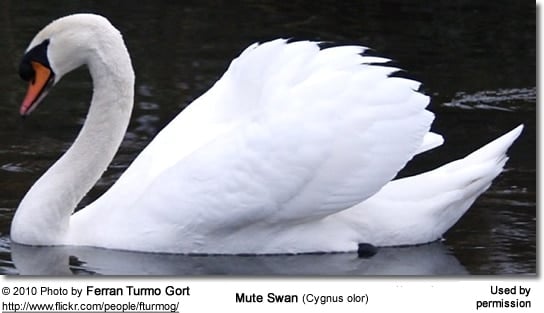
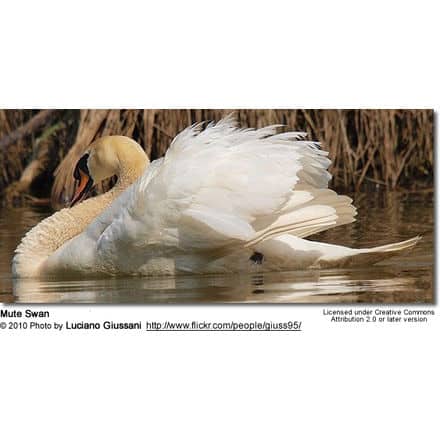
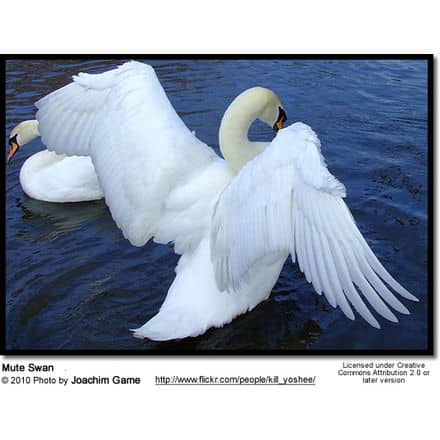
Please Note: The articles or images on this page are the sole property of the authors or photographers. Please contact them directly with respect to any copyright or licensing questions. Thank you.

